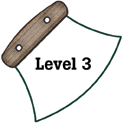
Alaska Science
Key Element A1
A student who meets the content standard should understand models describing the nature of molecules, atoms, and sub-atomic particles and the relation of the models to the structure and behavior of matter.
 |
Alaska Science A student who meets the content standard should understand models describing the nature of molecules, atoms, and sub-atomic particles and the relation of the models to the structure and behavior of matter. |
|
Performance Standard Level 3, Ages 11–14
|
|
|
|
Sample Assessment Ideas
|
|
|
Expanded Sample Assessment Idea
|
|
Procedure Students will:
Reflection and Revision
|
Levels of Performance |
||
|
Stage 4 |
Student work is complete, correct, and shows evidence of logical reasoning. The models and explanations accurately reflect the structure, arrangement, and motion of H2O in the three states. | ||
|
Stage 3
|
Student work may contain minor errors or omissions. The models and explanations reflect the structure, and motion of H2O in the three states. | ||
|
Stage 2
|
Student work may contain errors of science fact and reasoning. The models and explanations may show evidence of skilled craftsmanship but may be incomplete, incorrect or lack detail. | ||
|
Stage 1
|
Student models and explanations are largely incomplete or incorrect. | ||
Standards Cross-References
|
||
|
National Science Education Standards Develop descriptions, explanations, predictions, and models using evidence. Students should base their explanations on what they observed, and as they develop cognitive skills, they should be able to differentiate explanations from description—providing causes for effects and establishing relationships based on evidence and logical argument. (Page 145) A substance has characteristic properties, such as density, boiling point, and solubility, all of which are independent of the amount of the sample. A mixture of substances often can be separated into the original substances using one or more of the characteristic properties. (Page 154) |
Benchmarks Models are often used to think about processes that happen too slowly, too quickly, or on too small a scale to observe directly, or that are too vast to be changed deliberately, or that are potentially dangerous. (Page 269) Mathematical models can be displayed on a computer and then modified to see what happens. (Page 269) Different models can be used to represent the same thing. What kind of a model to use and how complex it should be depends on its purpose. The usefulness of a model may be limited if it is too simple or if it is needlessly complicated. Choosing a useful model is one of the instances in which intuition and creativity come into play in science, mathematics, and engineering.(Page 269) All matter is made up of atoms, which are far too small to see directly through a microscope. The atoms of any elements are alike but are different from atoms of other elements. Atoms may stick together in well-defined molecules or may be packed together in large arrays. Different arrangements of atoms into groups compose all substances. (Page 78) Equal volumes of different substances usually have different weights. (Page 78) Atoms and molecules are perpetually in motion. Increased temperature means greater average energy of motion , so most substances expand when heated. In solids, the atoms are closely locked in position and can only vibrate. In liquids, the atoms or molecules have higher energy, are more loosely connected, and can slide past one another; some molecules may get enough energy to escape into a gas. In gases, the atoms or molecules have still more energy and are free of one another except during occasional collisions. (Page 78) No matter how substances within a closed system interact with one another, or how they combine or break apart, the total weight of the system remains the same. The idea of atoms explains the conservation of matter: If the number of atoms stays the same no matter how they are rearranged, then their total mass stays the same. (Page 79) |
|
Table of Contents | Return to Alaska Native Knowledge Network